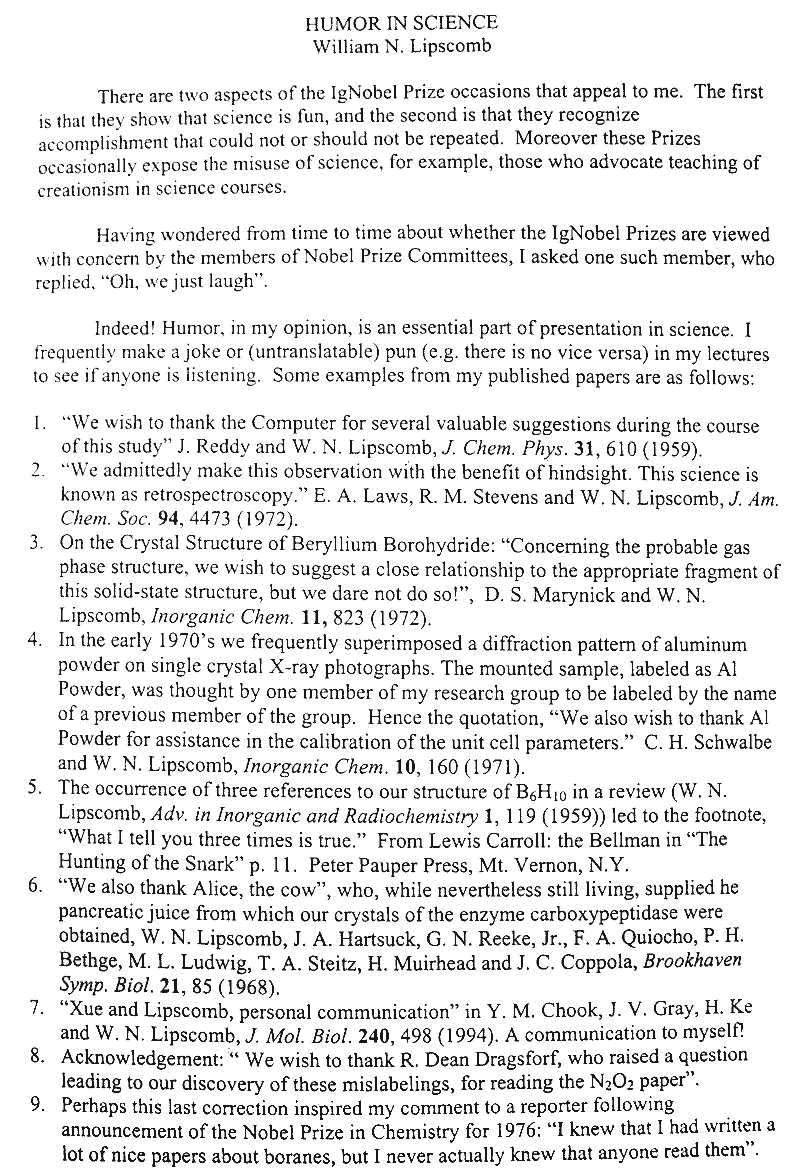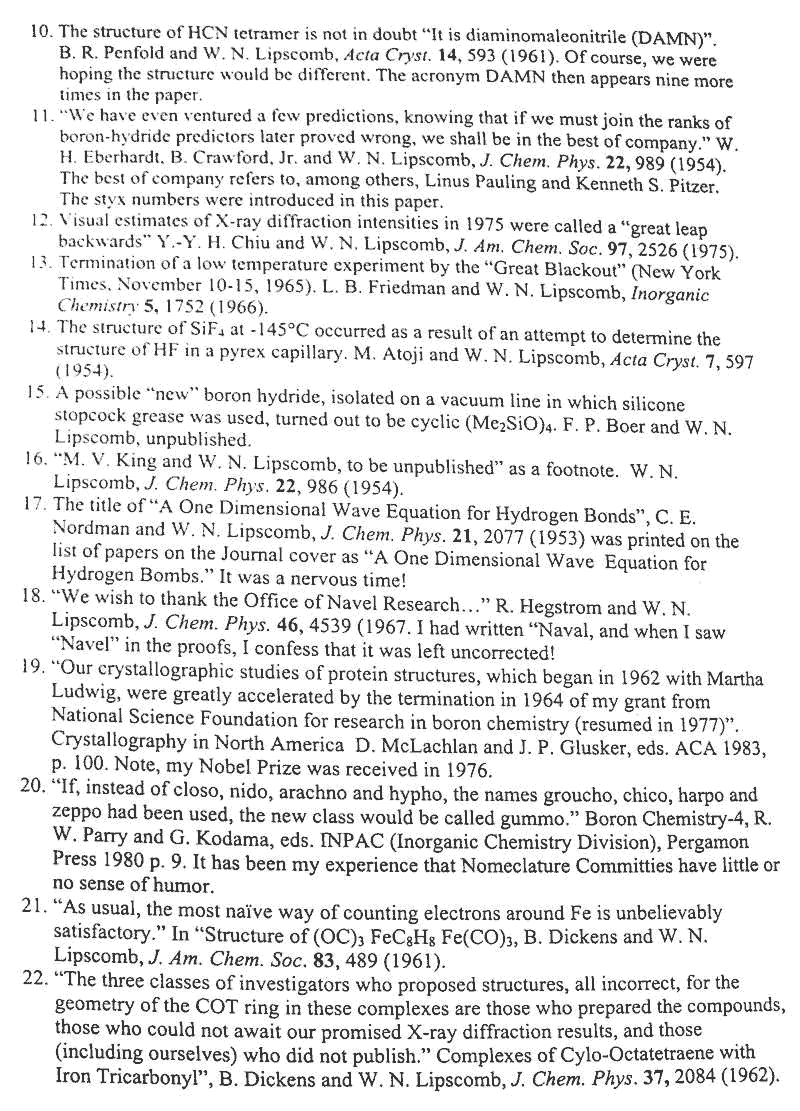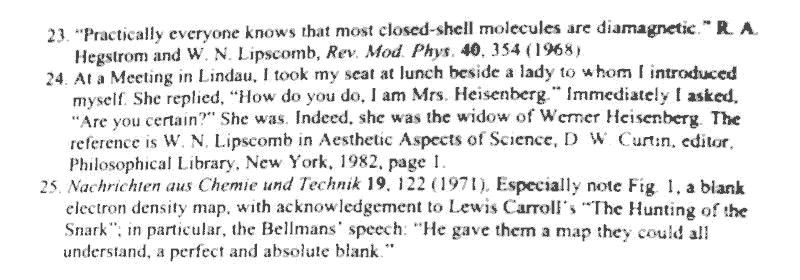Humor in Science
Lipscomb, WN. Humor in Science, manuscript, date uncertain: 1994-2009. Unpublished, except of course here on the Internet and in pieces in the publications cited.



Images converted to text:
HUMOR IN SCIENCE
William N. Lipscomb
There
are two aspects of the Ig Nobel Prize occasions that appeal to
me. The first is that they show that science is fun, and
the second is that they recognize accomplishments that could
not or should not be repeated. Moreover these Prizes
occasionally expose the misuse of science, for example, those
who advocate teaching of creationism in science courses.
Having
wondered from time to time about whether the IgNobel Prizes
are viewed with concern by members of the Nobel Prize
Committees, I asked one such member, who replied, "Oh, we just
laugh".
Indeed!
Humor, in my opinion, is an essential part of presentation in
science. I frequently make a joke or (untranslatable)
pun (e.g. there is no vice versa) in my lectures to see if
anyone is listening. Some examples from my published
papers as follows:
1. "We wish to thank the Computer for several valuable suggestions during the course of this study" J. Reddy and W. N. Lipscomb, J. Chem. Phys. 31, 610 (1959).
2. “We admittedly made this observation with the benefit of hindsight. This science is known as retrospectroscopy.” E. A. Laws, R. M. Stevens, and W. N. Lipscomb, J. Am. Chem. Soc. 94, 4473 (1972).
3. On the Crystal Structure of Beryllium Borohydride: "Concerning the probable gas phase structure, we wish to suggest a close relationship to the appropriate fragment of this solid-state structure, but we dare not do so!" D. S. Marynick and W. N, Lipscomb, Inorganic Chem. 11, 823 (1972).
4. “In the early 1970’s we frequently superimposed a diffraction pattern of aluminum powder on single crystal X-ray photographs [for calibration]. The mounted sample, labeled as Al Powder, was thought by one member of my research group to be labeled by the name of a previous member of the group. Hence the quotation,” “We also wish to thank Al Powder for assistance in the calibration of the unit cell parameters.” C. H. Schwalbe, and W. N. Lipscomb, Inorganic Chem. 10, 160 (1971).
5. The occurrence of three references to our structure of B6H10 in a review (W. N. Lipscomb, Adv. in Inorganic and Radiochemistry 1, 119 (1959)) led to the footnote, "What I tell you three times is true." From Lewis Carroll: the Bellman in "The Hunting of the Snark” p. l l. Peter Pauper Press, Mt. Vernon, N.Y.
6. “We also thank Alice, the cow, who while nevertheless still living, supplied the pancreatic juice from which our crystals of the enzyme carboxypeptidase were obtained.” W. N. Lipscomb, J. A. Hartsuck, G. N. Reeke, Jr., F. A. Quiocho, P. H. Bethge, M. L. Ludwig, T. A. Steitz, H. Muirhead, and J. C. Coppola, Brookhaven Symp. Biol. 21, 85 (1968).
7. "Xue and Lipscomb, personal communication" in Y. M. Chook, J. V. Gray, H. Ke and W. N. Lipscomb, J. Mol. Biol. 240, 498 (1994). A communication to myself!
8. Acknowledgement: “We wish to thank R. Dean Dragsforf, who raised a question leading to our discovery of these mislabelings, for reading the N2O2 paper”.
9. Perhaps this last correction inspired my comment to a reporter following announcement of the Nobel Prize in Chemistry for 1976: "I knew that I had written a lot of nice papers about boranes, but I never actually knew that anyone read them”.
10. The structure of HCN tetramer is not in doubt "It is diaminomaleonitrile (DAMN)”. B. R. Penfold and W. N. Lipscomb, Acta Cryst. 14, 593 (1961). Of course, we were hoping the structure would be different. The acronym DAMN then appears nine more times in the paper.
11. “We have even ventured a few predictions, knowing that if we must join the ranks of boron-hydride predictors later proved wrong, we shall be in the best of company”. W. H. Eberhardt. B. Crawford. Jr. and W. N. Lipscomb, J. Chem. Phys. 22, 989 (1954). The best of company refers to, among others, Linus Pauling and Kenneth S. Pitzer. The styx numbers were introduced in this paper.
12. Visual estimates of X-ray diffraction intensities in l975 were called a "great leap backwards" Y.-Y. H. Chiu and W. N. Lipscomb, J. Am. Chem. Soc. 97, 2526 (1975).
13. Termination of a low temperature experiment by the "Great Blackout" (New York Times. November 10-15. 1965). L. B. Friedman and W. N. Lipscomb, Inorganic Chemistry 5, 1752 (l966).
14. The structure of SiF4 at -145°C occurred as a result of an attempt to determine the structure of HF in a pyrex capillary. M. Atoji and W. N. Lipscomb, Acta Cryst. 7, 597 (1954).
15. A possible "new" boron hydride, isolated on a vacuum line in which silicone stopcock grease was used, turned out to be cyclic (Me2SiO)4. F. P. Boer and W. N. Lipscomb, unpublished.
16. The footnote, “M. V. King and W. N. Lipscomb, to be unpublished,” W. N. Lipscomb, J. Chem. Phys. 22, 986 (1954).
17. The title of "A One Dimensional Wave Equation for Hydrogen Bonds", C. E. Nordman and W. N. Lipscomb, J. Chem. Phys. 21, 2077 (1953) was printed on the list of papers on the Journal cover as "A One Dimensional Wave Equation for Hydrogen Bombs." It was a nervous time!
18. “We wish to thank the Office of Navel Research….” [Navel, as in belly-button] R. Hegstrom and W. N. Lipscomb, J. Chem. Phys. 46, 4539 (1967). I had written “Naval”, and when I saw “Navel” in the proofs, I confess that it was left uncorrected! (But Bill had it corrected for the reprints –JL)
19. "Our crystallographic studies of protein structures, which began in 1962 with Martha Ludwig, were greatly accelerated by the termination in 1964 of my grant from National Science Foundation for research in boron chemistry (resumed in 1977)”. Crystallography in North America, D. McLachlan and J. P. Glusker, eds. ACA 1983, p. 100. Note, my Nobel Prize was received in 1976.
20. "lf, instead of closo, nido, arachno and hypho, the names groucho, chico, harpo and zeppo had been used, the new class would be called gummo.” Boron Chemistry-4, R. W. Parry and G. Kodama, eds. INPAC (Inorganic Chemistry Division), Pergamon Press 1980 p. 9. It has been my experience that Nomenclature Committees have little or no sense of humor.
21. "As usual, the most naive way of counting electrons around Fe is unbelievably satisfactory In Stucture of (OC)3 FeC8H8 Fe(CO)3, B. Dickens and W. N. Lipscomb, J. Am. Chem. Soc. 83, 489 (1961).
22. “The three classes of investigators who proposed structures, all incorrect, for the geometry of the COT ring in these complexes are those who prepared the compounds, those who could not await our promised X-ray diffraction results, and those (including ourselves) who did not publish.” Complexes of Cylo-Octatetraene with Iron Tricarbonyl, B. Dickens and W. N. Lipscomb, J. Chem. Phys. 37, 2084 (1962).
23. "Practically everyone knows that most closed-shell molecules are diamagnetic.” R. A. Hegstrom and W. N. Lipscomb. Rev. Mod Phys. 40, 354 (1968)
24. At a Meeting in Landau, I took my seat at lunch beside a lady to whom I introduced myself. She replied. "How do you do, I am Mrs. Heisenberg." Immediately I asked “Are you certain?” She was. Indeed. She was the widow of Werner Heisenberg. The reference is W. N. Lipscomb an Aesthetic Aspects of Science. D. W. Curing, editor. Philosophical Library. New York, 1982. page 1.
25. Nachrichten aus Chemie und Technik 19, 122 (1971) (Draft in English. Publication in German.) Especially note Fig. 1, a blank electron density map, with acknowledgment to Lewis Carroll’s “The Hunting of the Snark"; in particular. the Bellmans’ speech: "He gave them a map they could all understand, a perfect and absolute blank.”
Unpublished list, reprinted here with permission from William Lipscomb.
Bonus story: Quoting Sherlock Holmes in a boron hydride
paper
BIll's group solved a difficult problem "using the method of
Sherlock Holmes", as told in an
interview in 1996 with Marc Abrahams for the the Annals of
Improbable Research. A molecule was presented to the group as containing eight boron atoms. They tried out the possibilities for the B8 hydride, and finally concluded that there had to be a ninth boron atom. This is an illustration that in science if one eliminates all other possibilities, then if only one more remains, that must be correct.
That reminded Bill, who was then at the University of Minnesota and a member of the Baker Street Irregulars there (a chapter of the Sherlock Holmes Society), that In the complete works of Sherlock Holmes there are four places where Holmes states this principle, in one place like this, “Wherever all other contingency fails, whatever remains, no matter how improbable, must be the truth.” The other three places use similar but different wording.
Bill used this quote from Holmes in: “Boron Arrangement in a B9 Hydride,” Richard E. Dickerson, Peter J. Wheatley, Peter A. Howell, William N. Lipscomb, and Riley Schaeffer, Journal of Chemical Physics, vol. 25, no. 3, Sept. 1956, pp. 606-607. Footnote 4 of the paper quotes Sherlock Holmes describing his theory of contingencies. The quotation is from the Arthur Conan Doyle story, “The Bruce Partington Plans.”
This web page is published under the terms of the Creative Commons copyright below in the book, The Selected Papers of William N Lipscomb Jr.: A Legacy in Structure-Function Relationships.
-- Nov. 2009, last updated Apr. 2013.
 Home page https://wlipscomb.tripod.com/
Home page https://wlipscomb.tripod.com/